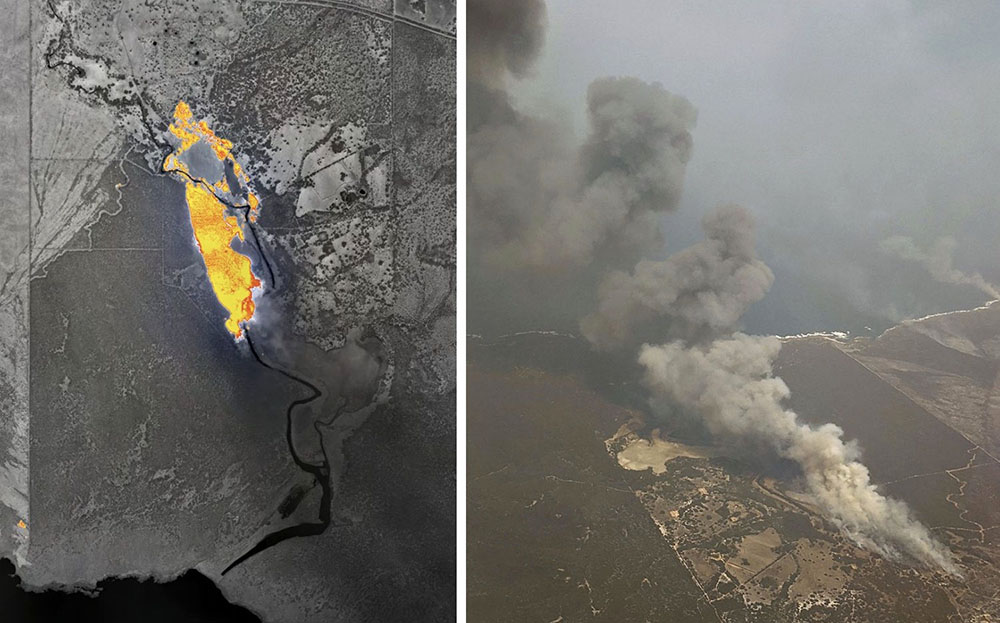
At Wildfire Today we have often advocated for what we call the Holy Grail of Wildland Firefighter Safety — making available to fire personnel the real time location of the fire and firefighting resources. Several systems for tracking the fire or resources have been demonstrated or used on a small scale by federal land management agencies in the United States. Hundreds if not thousands of law enforcement agencies, fire departments, and private corporations have been using tracking systems for years.
A company in Australia has developed a system to deliver half of the Holy Grail, the real time position of a wildfire. FireFlight Technologies, with CEO Dr. Paul Dare, a long-term South Australian Country Fire Services (CFS) volunteer, has been awarded a $100,000 grant to demonstrate its real time mapping system.
Using infrared thermal sensing equipment in an aircraft it can see through smoke to detect the location of a wildfire.
Below is an excerpt from an article at Cosmos Magazine, January 7, 2022:
…“The other live information we get from the camera system is contextual,” says Dare. “We can see features such as trees, creeks, roads, buildings – even cars. Anyone looking at the map would recognize these features and understand the implications.”
“There are two ways of thinking about it. First, the chief is back at headquarters with a strategic view. They can move a dozen fire appliances from one side of the fire front to the other. This can take hours to achieve.
“Then there are the people on the fire trucks. They’re approaching the fire much more tactically. Their decision making is going to be based on seconds and minutes.”
This summer, Dare’s system will transmit rapidly updating high-resolution images onto a web-based portal. From there, CFS officers can interpret the bushfire’s behavior to reposition ground crews, deploy fire bombers and issue evacuation alerts accordingly.
The technology has already been put through its paces. Data from the sensor was relayed to defense personnel during the 2019–2020 Kangaroo Island bushfires. It’s also been used during recent wildfires in Montana and California.
“We build and supply our own hardware,” Dare said. “We make a set of equipment work together and put it in a box that can be bolted on a helicopter or plane. We give the pilot a portable computer to control it. That way, we know it’s all going to work.”
What’s happening in the United States?
In the US, the John D. Dingell, Jr. Conservation, Management, and Recreation Act required that by March 12, 2021 the five federal land management agencies “…develop consistent protocols and plans for the use on wildland fires of unmanned aircraft system technologies, including for the development of real-time maps of the location of wildland fires.”
While this technology has been demonstrated, real time mapping appears to be far from being used routinely.
The Dingell Act also mandated that the five federal land management agencies “jointly develop and operate a tracking system to remotely locate the positions of fire resources for use by wildland firefighters, including, at a minimum, any fire resources assigned to Federal type 1 wildland fire incident management teams”, due by March 12, 2021.
The US Bureau of Land Management has installed hardware for Location Based Services (LBS) which are now operational on more than 700 wildland fire engines, crew transports, and support vehicles. Vehicle position and utilization data are visually displayed via a web-based portal or mobile device application.
Ten months after it was required by Congress the US Forest Service has made very little progress on this mandate.
Thanks and a tip of the hat go out to Gerald.

It is great to see advances everywhere. Actual technology used these last two fire seasons in California and most of the West include real-time gps tracking federal and state resources , several similar or better that this system as the ones from Courtney Aviation, Overwatch and others, and National Guard Fire data in real time, a big game changer Finally the technology is there, and it is being adopted, now it is about how to improve workflows to benefit of this new tools. Users will make them work , it will just take training and a little time, but change is here.
Or just use currently available military tech. Why pay some contractor big bucks for a system that isn’t even close to the systems we have from 20 years ago? The proposed system here isn’t even very reliable…
After spending a month at 2 of their bases during the height of that blowout season I got to see and use some of this technology. It is frankly an incredible tool and once they work out all the bugs it’s going to give fire mangers/ firefighters a huge addition to their tool chest.